Nursing Strategies: Post-operative Pain Management and Wound Care
VerifiedAdded on 2023/06/15
|11
|1503
|426
Report
AI Summary
This nursing assignment focuses on the post-operative care of a 24-year-old male patient, Mike, who sustained a tibia and fibula fracture from a motorcycle accident and underwent open reduction and internal fixation (ORIF). The assignment identifies key nursing priorities, including effective pain management and prevention of secondary site infection (SSI). It details the nursing diagnosis process using a DRSABCD approach, highlighting the patient's acute pain and potential infection risks. The assignment outlines SMART goals for pain management, including administering analgesics and monitoring vital signs, as well as strategies for wound prevention, such as wound management education and the use of hydrofibre dressings. Evaluation methods, like the Braden scale and monitoring wound diameter reduction, are discussed to assess the effectiveness of the planned interventions. Desklib offers additional resources, including past papers and solved assignments, to aid nursing students in mastering post-operative care techniques.
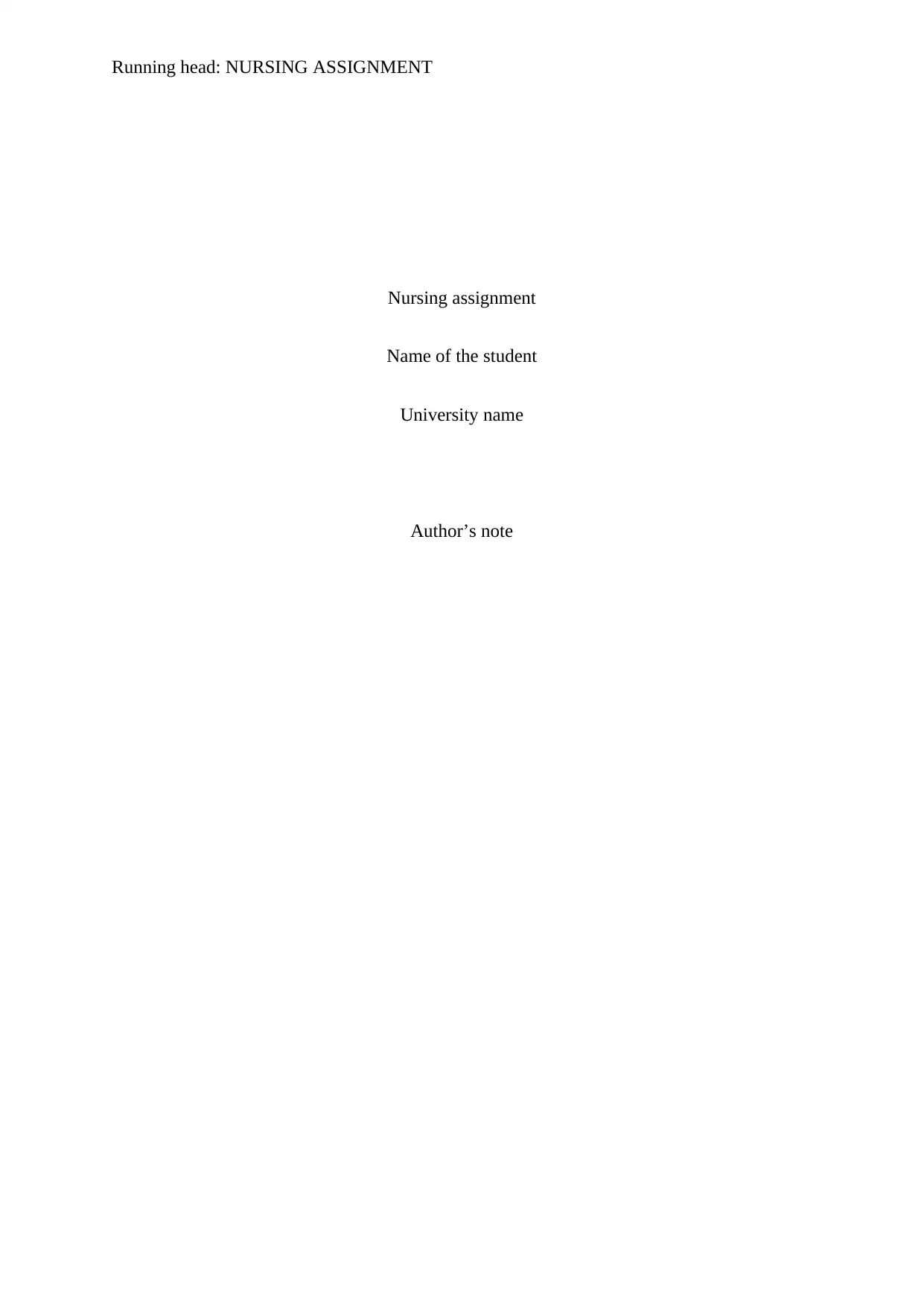
Running head: NURSING ASSIGNMENT
Nursing assignment
Name of the student
University name
Author’s note
Nursing assignment
Name of the student
University name
Author’s note
Paraphrase This Document
Need a fresh take? Get an instant paraphrase of this document with our AI Paraphraser
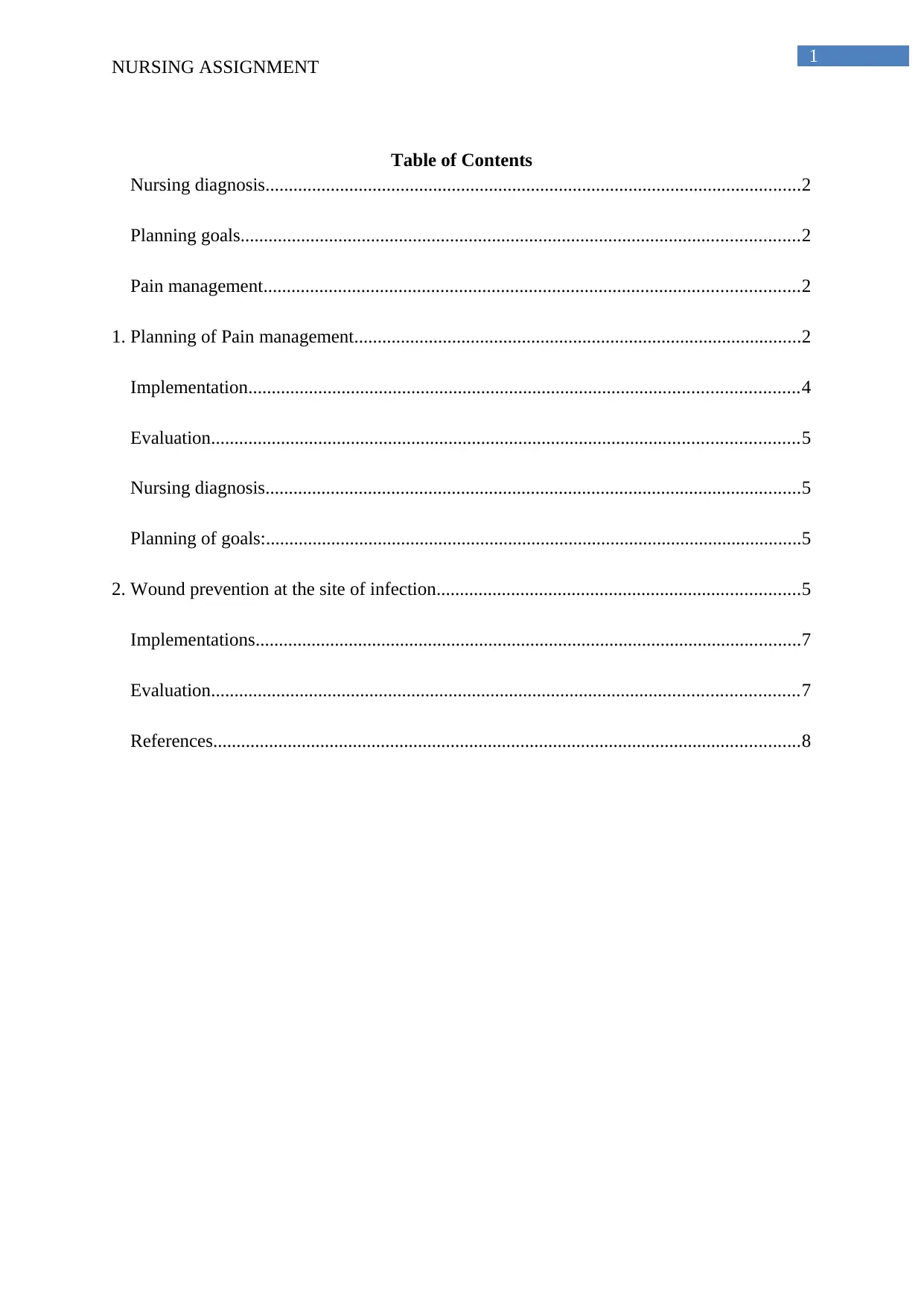
1
NURSING ASSIGNMENT
Table of Contents
Nursing diagnosis...................................................................................................................2
Planning goals........................................................................................................................2
Pain management...................................................................................................................2
1. Planning of Pain management................................................................................................2
Implementation......................................................................................................................4
Evaluation..............................................................................................................................5
Nursing diagnosis...................................................................................................................5
Planning of goals:...................................................................................................................5
2. Wound prevention at the site of infection..............................................................................5
Implementations.....................................................................................................................7
Evaluation..............................................................................................................................7
References..............................................................................................................................8
NURSING ASSIGNMENT
Table of Contents
Nursing diagnosis...................................................................................................................2
Planning goals........................................................................................................................2
Pain management...................................................................................................................2
1. Planning of Pain management................................................................................................2
Implementation......................................................................................................................4
Evaluation..............................................................................................................................5
Nursing diagnosis...................................................................................................................5
Planning of goals:...................................................................................................................5
2. Wound prevention at the site of infection..............................................................................5
Implementations.....................................................................................................................7
Evaluation..............................................................................................................................7
References..............................................................................................................................8
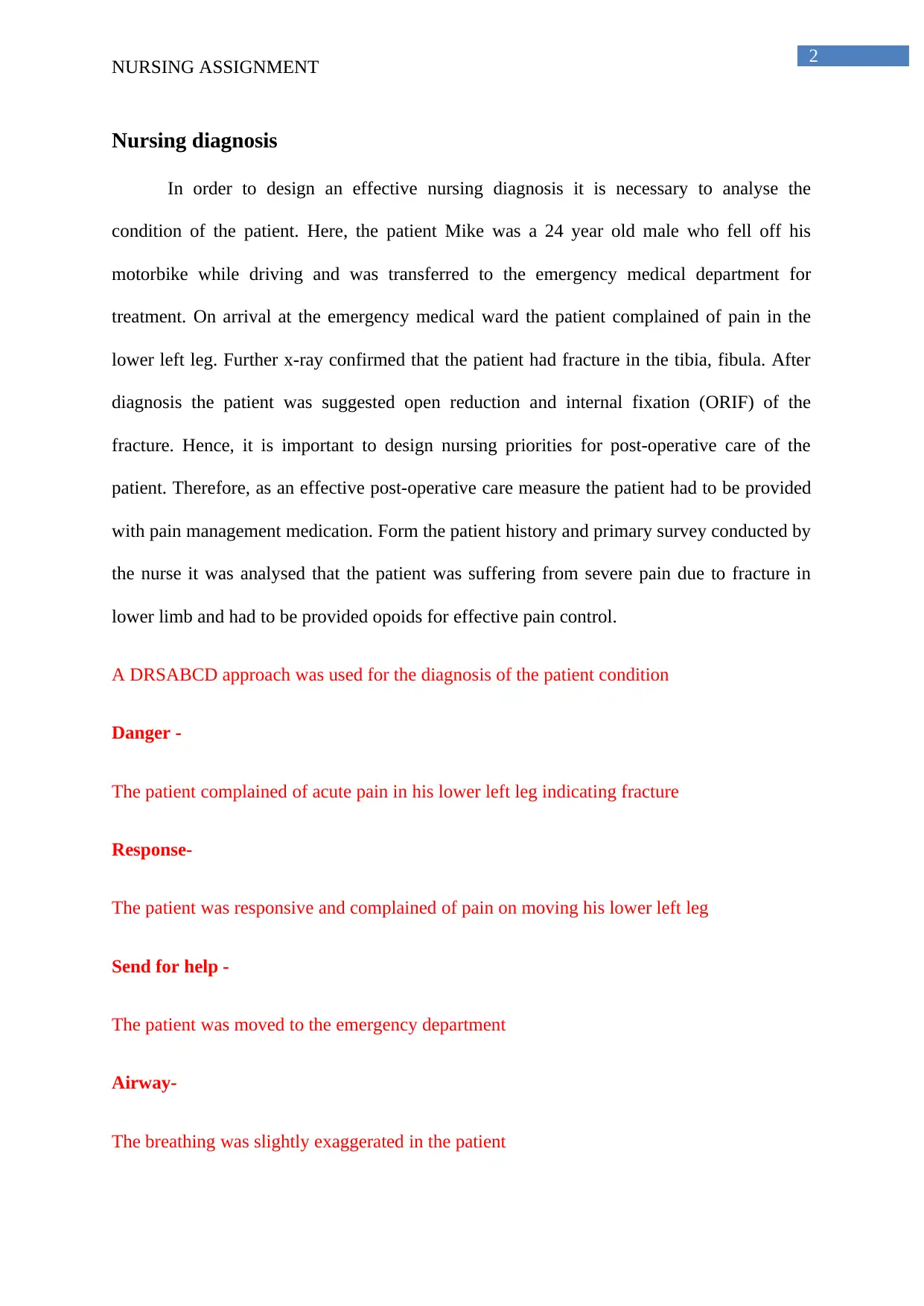
2
NURSING ASSIGNMENT
Nursing diagnosis
In order to design an effective nursing diagnosis it is necessary to analyse the
condition of the patient. Here, the patient Mike was a 24 year old male who fell off his
motorbike while driving and was transferred to the emergency medical department for
treatment. On arrival at the emergency medical ward the patient complained of pain in the
lower left leg. Further x-ray confirmed that the patient had fracture in the tibia, fibula. After
diagnosis the patient was suggested open reduction and internal fixation (ORIF) of the
fracture. Hence, it is important to design nursing priorities for post-operative care of the
patient. Therefore, as an effective post-operative care measure the patient had to be provided
with pain management medication. Form the patient history and primary survey conducted by
the nurse it was analysed that the patient was suffering from severe pain due to fracture in
lower limb and had to be provided opoids for effective pain control.
A DRSABCD approach was used for the diagnosis of the patient condition
Danger -
The patient complained of acute pain in his lower left leg indicating fracture
Response-
The patient was responsive and complained of pain on moving his lower left leg
Send for help -
The patient was moved to the emergency department
Airway-
The breathing was slightly exaggerated in the patient
NURSING ASSIGNMENT
Nursing diagnosis
In order to design an effective nursing diagnosis it is necessary to analyse the
condition of the patient. Here, the patient Mike was a 24 year old male who fell off his
motorbike while driving and was transferred to the emergency medical department for
treatment. On arrival at the emergency medical ward the patient complained of pain in the
lower left leg. Further x-ray confirmed that the patient had fracture in the tibia, fibula. After
diagnosis the patient was suggested open reduction and internal fixation (ORIF) of the
fracture. Hence, it is important to design nursing priorities for post-operative care of the
patient. Therefore, as an effective post-operative care measure the patient had to be provided
with pain management medication. Form the patient history and primary survey conducted by
the nurse it was analysed that the patient was suffering from severe pain due to fracture in
lower limb and had to be provided opoids for effective pain control.
A DRSABCD approach was used for the diagnosis of the patient condition
Danger -
The patient complained of acute pain in his lower left leg indicating fracture
Response-
The patient was responsive and complained of pain on moving his lower left leg
Send for help -
The patient was moved to the emergency department
Airway-
The breathing was slightly exaggerated in the patient
⊘ This is a preview!⊘
Do you want full access?
Subscribe today to unlock all pages.

Trusted by 1+ million students worldwide
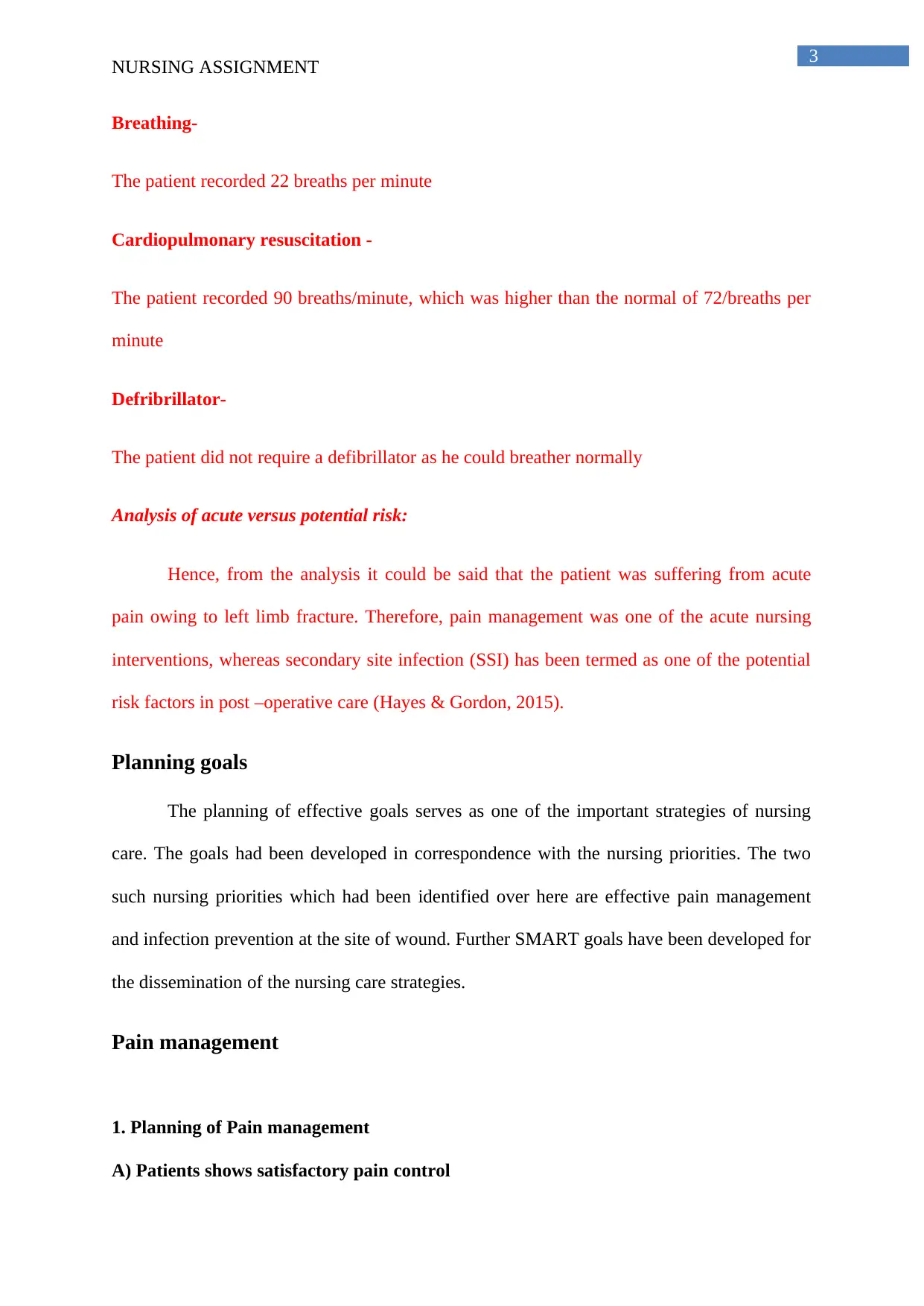
3
NURSING ASSIGNMENT
Breathing-
The patient recorded 22 breaths per minute
Cardiopulmonary resuscitation -
The patient recorded 90 breaths/minute, which was higher than the normal of 72/breaths per
minute
Defribrillator-
The patient did not require a defibrillator as he could breather normally
Analysis of acute versus potential risk:
Hence, from the analysis it could be said that the patient was suffering from acute
pain owing to left limb fracture. Therefore, pain management was one of the acute nursing
interventions, whereas secondary site infection (SSI) has been termed as one of the potential
risk factors in post –operative care (Hayes & Gordon, 2015).
Planning goals
The planning of effective goals serves as one of the important strategies of nursing
care. The goals had been developed in correspondence with the nursing priorities. The two
such nursing priorities which had been identified over here are effective pain management
and infection prevention at the site of wound. Further SMART goals have been developed for
the dissemination of the nursing care strategies.
Pain management
1. Planning of Pain management
A) Patients shows satisfactory pain control
NURSING ASSIGNMENT
Breathing-
The patient recorded 22 breaths per minute
Cardiopulmonary resuscitation -
The patient recorded 90 breaths/minute, which was higher than the normal of 72/breaths per
minute
Defribrillator-
The patient did not require a defibrillator as he could breather normally
Analysis of acute versus potential risk:
Hence, from the analysis it could be said that the patient was suffering from acute
pain owing to left limb fracture. Therefore, pain management was one of the acute nursing
interventions, whereas secondary site infection (SSI) has been termed as one of the potential
risk factors in post –operative care (Hayes & Gordon, 2015).
Planning goals
The planning of effective goals serves as one of the important strategies of nursing
care. The goals had been developed in correspondence with the nursing priorities. The two
such nursing priorities which had been identified over here are effective pain management
and infection prevention at the site of wound. Further SMART goals have been developed for
the dissemination of the nursing care strategies.
Pain management
1. Planning of Pain management
A) Patients shows satisfactory pain control
Paraphrase This Document
Need a fresh take? Get an instant paraphrase of this document with our AI Paraphraser
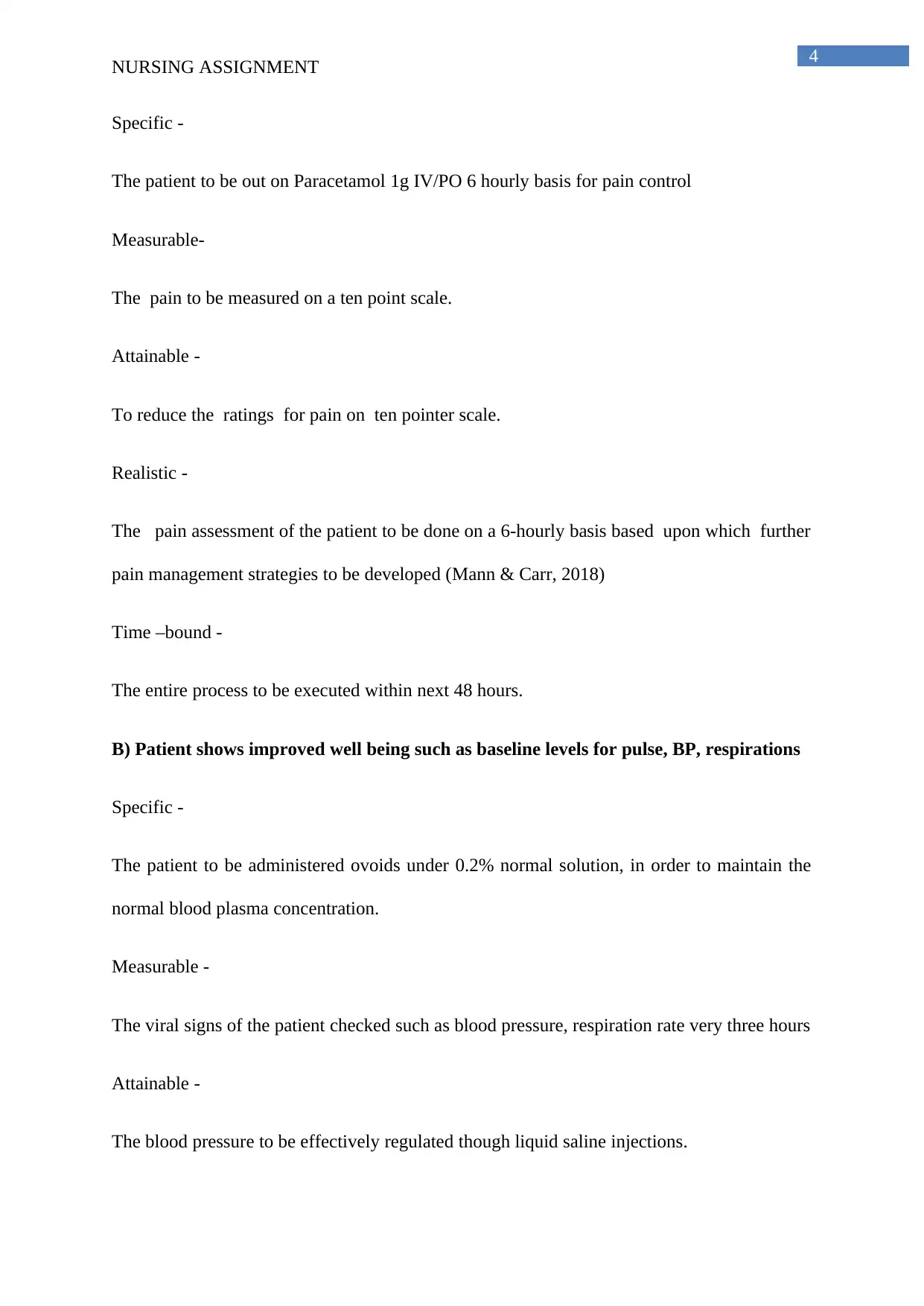
4
NURSING ASSIGNMENT
Specific -
The patient to be out on Paracetamol 1g IV/PO 6 hourly basis for pain control
Measurable-
The pain to be measured on a ten point scale.
Attainable -
To reduce the ratings for pain on ten pointer scale.
Realistic -
The pain assessment of the patient to be done on a 6-hourly basis based upon which further
pain management strategies to be developed (Mann & Carr, 2018)
Time –bound -
The entire process to be executed within next 48 hours.
B) Patient shows improved well being such as baseline levels for pulse, BP, respirations
Specific -
The patient to be administered ovoids under 0.2% normal solution, in order to maintain the
normal blood plasma concentration.
Measurable -
The viral signs of the patient checked such as blood pressure, respiration rate very three hours
Attainable -
The blood pressure to be effectively regulated though liquid saline injections.
NURSING ASSIGNMENT
Specific -
The patient to be out on Paracetamol 1g IV/PO 6 hourly basis for pain control
Measurable-
The pain to be measured on a ten point scale.
Attainable -
To reduce the ratings for pain on ten pointer scale.
Realistic -
The pain assessment of the patient to be done on a 6-hourly basis based upon which further
pain management strategies to be developed (Mann & Carr, 2018)
Time –bound -
The entire process to be executed within next 48 hours.
B) Patient shows improved well being such as baseline levels for pulse, BP, respirations
Specific -
The patient to be administered ovoids under 0.2% normal solution, in order to maintain the
normal blood plasma concentration.
Measurable -
The viral signs of the patient checked such as blood pressure, respiration rate very three hours
Attainable -
The blood pressure to be effectively regulated though liquid saline injections.
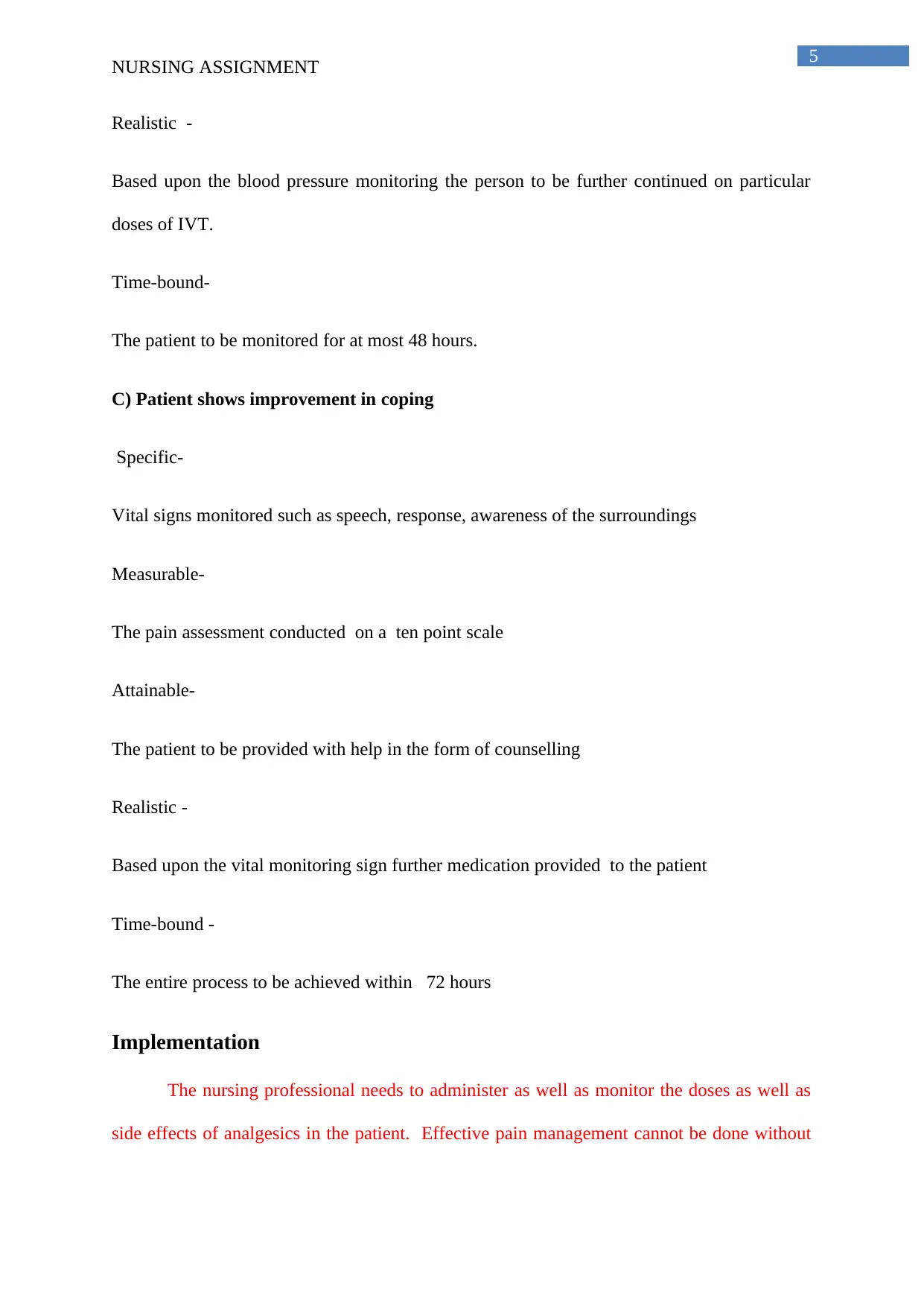
5
NURSING ASSIGNMENT
Realistic -
Based upon the blood pressure monitoring the person to be further continued on particular
doses of IVT.
Time-bound-
The patient to be monitored for at most 48 hours.
C) Patient shows improvement in coping
Specific-
Vital signs monitored such as speech, response, awareness of the surroundings
Measurable-
The pain assessment conducted on a ten point scale
Attainable-
The patient to be provided with help in the form of counselling
Realistic -
Based upon the vital monitoring sign further medication provided to the patient
Time-bound -
The entire process to be achieved within 72 hours
Implementation
The nursing professional needs to administer as well as monitor the doses as well as
side effects of analgesics in the patient. Effective pain management cannot be done without
NURSING ASSIGNMENT
Realistic -
Based upon the blood pressure monitoring the person to be further continued on particular
doses of IVT.
Time-bound-
The patient to be monitored for at most 48 hours.
C) Patient shows improvement in coping
Specific-
Vital signs monitored such as speech, response, awareness of the surroundings
Measurable-
The pain assessment conducted on a ten point scale
Attainable-
The patient to be provided with help in the form of counselling
Realistic -
Based upon the vital monitoring sign further medication provided to the patient
Time-bound -
The entire process to be achieved within 72 hours
Implementation
The nursing professional needs to administer as well as monitor the doses as well as
side effects of analgesics in the patient. Effective pain management cannot be done without
⊘ This is a preview!⊘
Do you want full access?
Subscribe today to unlock all pages.

Trusted by 1+ million students worldwide
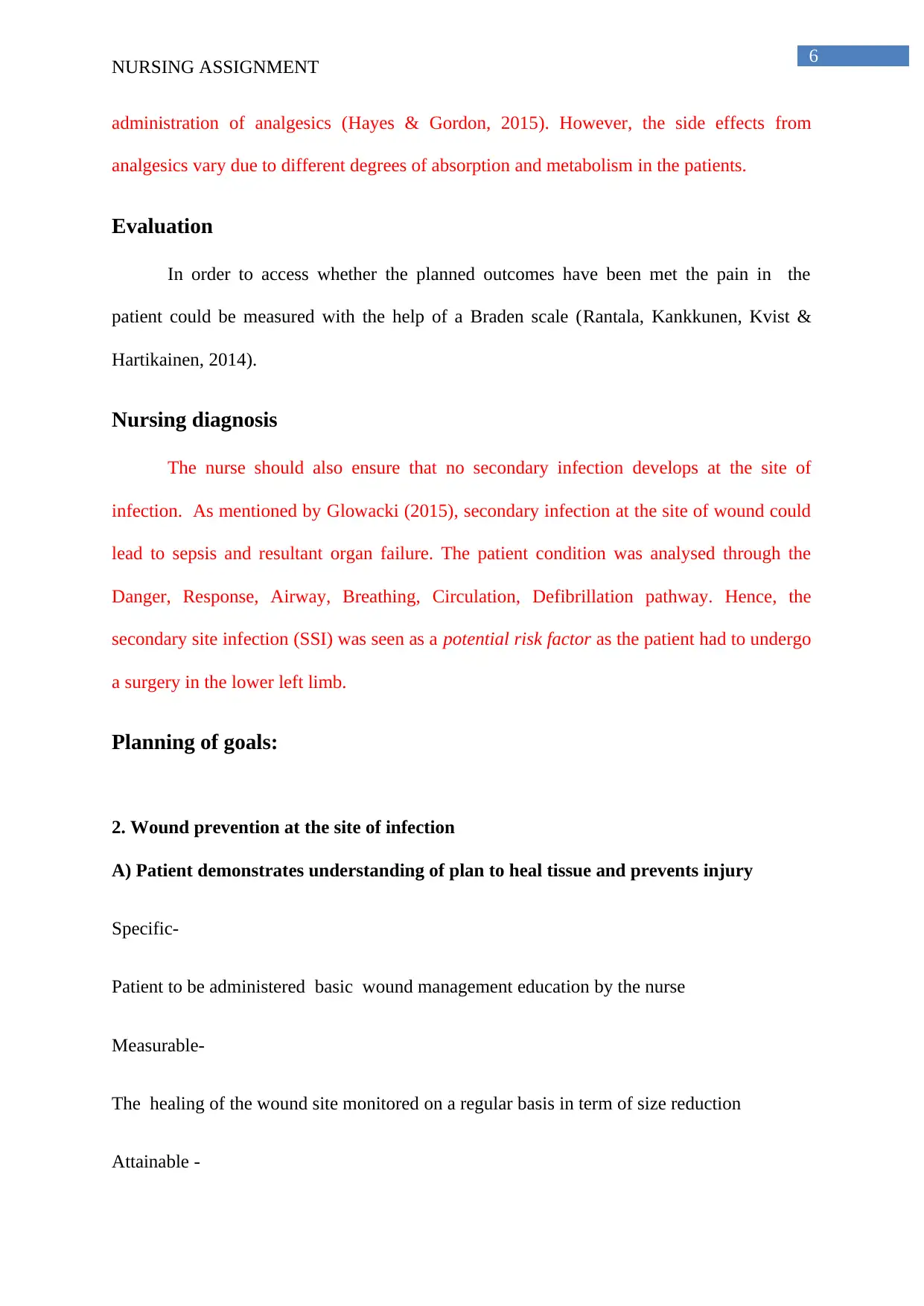
6
NURSING ASSIGNMENT
administration of analgesics (Hayes & Gordon, 2015). However, the side effects from
analgesics vary due to different degrees of absorption and metabolism in the patients.
Evaluation
In order to access whether the planned outcomes have been met the pain in the
patient could be measured with the help of a Braden scale (Rantala, Kankkunen, Kvist &
Hartikainen, 2014).
Nursing diagnosis
The nurse should also ensure that no secondary infection develops at the site of
infection. As mentioned by Glowacki (2015), secondary infection at the site of wound could
lead to sepsis and resultant organ failure. The patient condition was analysed through the
Danger, Response, Airway, Breathing, Circulation, Defibrillation pathway. Hence, the
secondary site infection (SSI) was seen as a potential risk factor as the patient had to undergo
a surgery in the lower left limb.
Planning of goals:
2. Wound prevention at the site of infection
A) Patient demonstrates understanding of plan to heal tissue and prevents injury
Specific-
Patient to be administered basic wound management education by the nurse
Measurable-
The healing of the wound site monitored on a regular basis in term of size reduction
Attainable -
NURSING ASSIGNMENT
administration of analgesics (Hayes & Gordon, 2015). However, the side effects from
analgesics vary due to different degrees of absorption and metabolism in the patients.
Evaluation
In order to access whether the planned outcomes have been met the pain in the
patient could be measured with the help of a Braden scale (Rantala, Kankkunen, Kvist &
Hartikainen, 2014).
Nursing diagnosis
The nurse should also ensure that no secondary infection develops at the site of
infection. As mentioned by Glowacki (2015), secondary infection at the site of wound could
lead to sepsis and resultant organ failure. The patient condition was analysed through the
Danger, Response, Airway, Breathing, Circulation, Defibrillation pathway. Hence, the
secondary site infection (SSI) was seen as a potential risk factor as the patient had to undergo
a surgery in the lower left limb.
Planning of goals:
2. Wound prevention at the site of infection
A) Patient demonstrates understanding of plan to heal tissue and prevents injury
Specific-
Patient to be administered basic wound management education by the nurse
Measurable-
The healing of the wound site monitored on a regular basis in term of size reduction
Attainable -
Paraphrase This Document
Need a fresh take? Get an instant paraphrase of this document with our AI Paraphraser
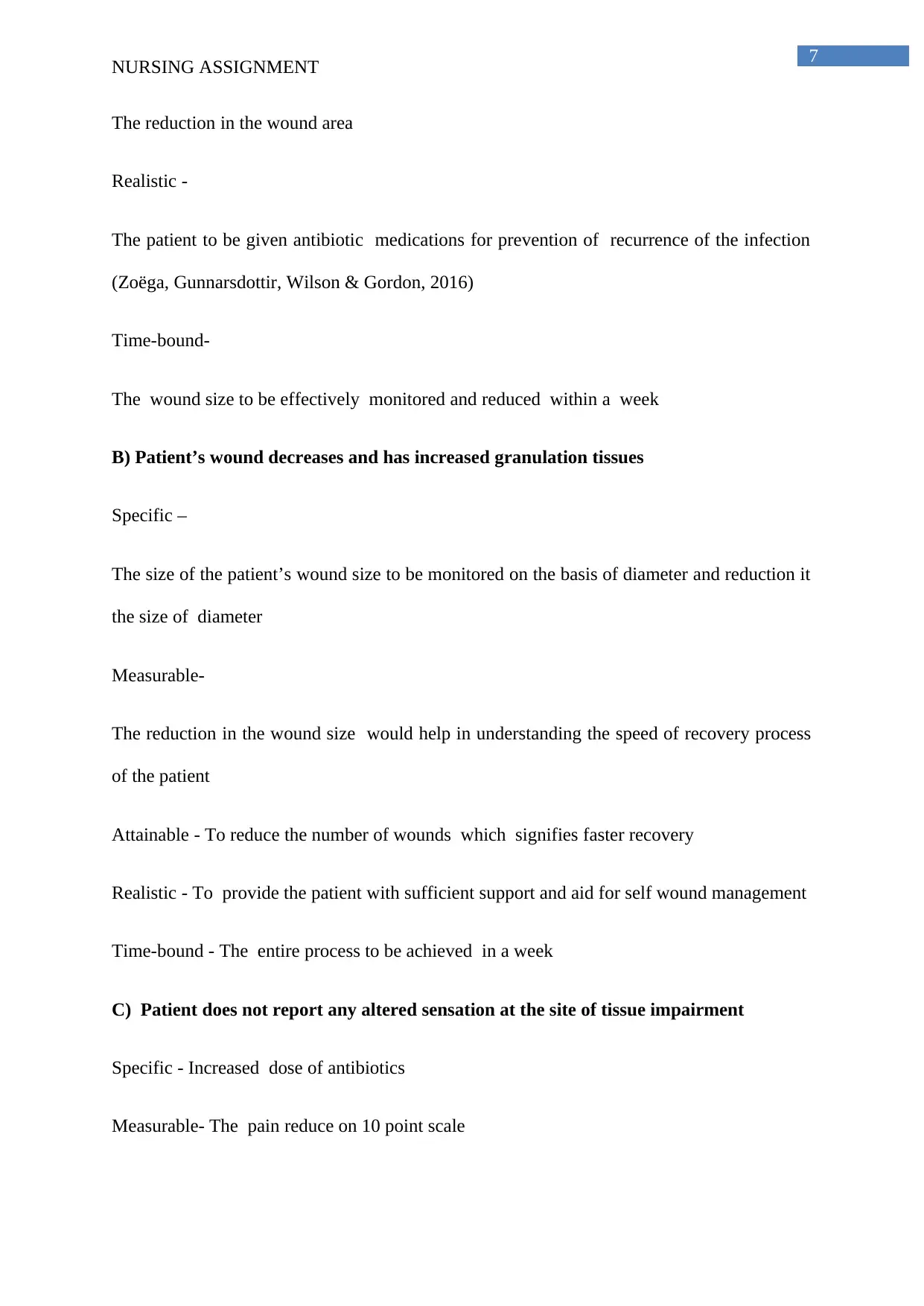
7
NURSING ASSIGNMENT
The reduction in the wound area
Realistic -
The patient to be given antibiotic medications for prevention of recurrence of the infection
(Zoëga, Gunnarsdottir, Wilson & Gordon, 2016)
Time-bound-
The wound size to be effectively monitored and reduced within a week
B) Patient’s wound decreases and has increased granulation tissues
Specific –
The size of the patient’s wound size to be monitored on the basis of diameter and reduction it
the size of diameter
Measurable-
The reduction in the wound size would help in understanding the speed of recovery process
of the patient
Attainable - To reduce the number of wounds which signifies faster recovery
Realistic - To provide the patient with sufficient support and aid for self wound management
Time-bound - The entire process to be achieved in a week
C) Patient does not report any altered sensation at the site of tissue impairment
Specific - Increased dose of antibiotics
Measurable- The pain reduce on 10 point scale
NURSING ASSIGNMENT
The reduction in the wound area
Realistic -
The patient to be given antibiotic medications for prevention of recurrence of the infection
(Zoëga, Gunnarsdottir, Wilson & Gordon, 2016)
Time-bound-
The wound size to be effectively monitored and reduced within a week
B) Patient’s wound decreases and has increased granulation tissues
Specific –
The size of the patient’s wound size to be monitored on the basis of diameter and reduction it
the size of diameter
Measurable-
The reduction in the wound size would help in understanding the speed of recovery process
of the patient
Attainable - To reduce the number of wounds which signifies faster recovery
Realistic - To provide the patient with sufficient support and aid for self wound management
Time-bound - The entire process to be achieved in a week
C) Patient does not report any altered sensation at the site of tissue impairment
Specific - Increased dose of antibiotics
Measurable- The pain reduce on 10 point scale
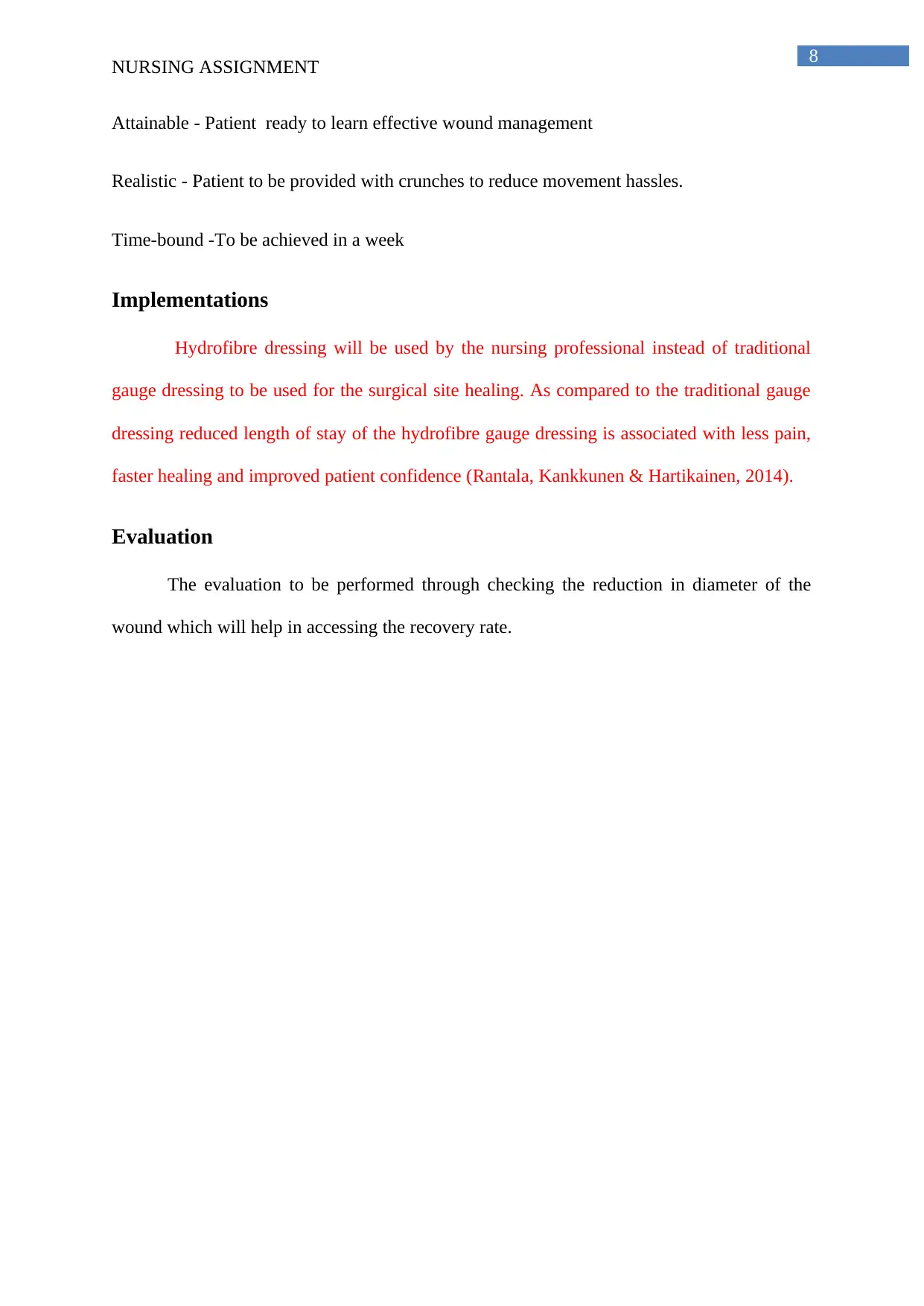
8
NURSING ASSIGNMENT
Attainable - Patient ready to learn effective wound management
Realistic - Patient to be provided with crunches to reduce movement hassles.
Time-bound -To be achieved in a week
Implementations
Hydrofibre dressing will be used by the nursing professional instead of traditional
gauge dressing to be used for the surgical site healing. As compared to the traditional gauge
dressing reduced length of stay of the hydrofibre gauge dressing is associated with less pain,
faster healing and improved patient confidence (Rantala, Kankkunen & Hartikainen, 2014).
Evaluation
The evaluation to be performed through checking the reduction in diameter of the
wound which will help in accessing the recovery rate.
NURSING ASSIGNMENT
Attainable - Patient ready to learn effective wound management
Realistic - Patient to be provided with crunches to reduce movement hassles.
Time-bound -To be achieved in a week
Implementations
Hydrofibre dressing will be used by the nursing professional instead of traditional
gauge dressing to be used for the surgical site healing. As compared to the traditional gauge
dressing reduced length of stay of the hydrofibre gauge dressing is associated with less pain,
faster healing and improved patient confidence (Rantala, Kankkunen & Hartikainen, 2014).
Evaluation
The evaluation to be performed through checking the reduction in diameter of the
wound which will help in accessing the recovery rate.
⊘ This is a preview!⊘
Do you want full access?
Subscribe today to unlock all pages.

Trusted by 1+ million students worldwide
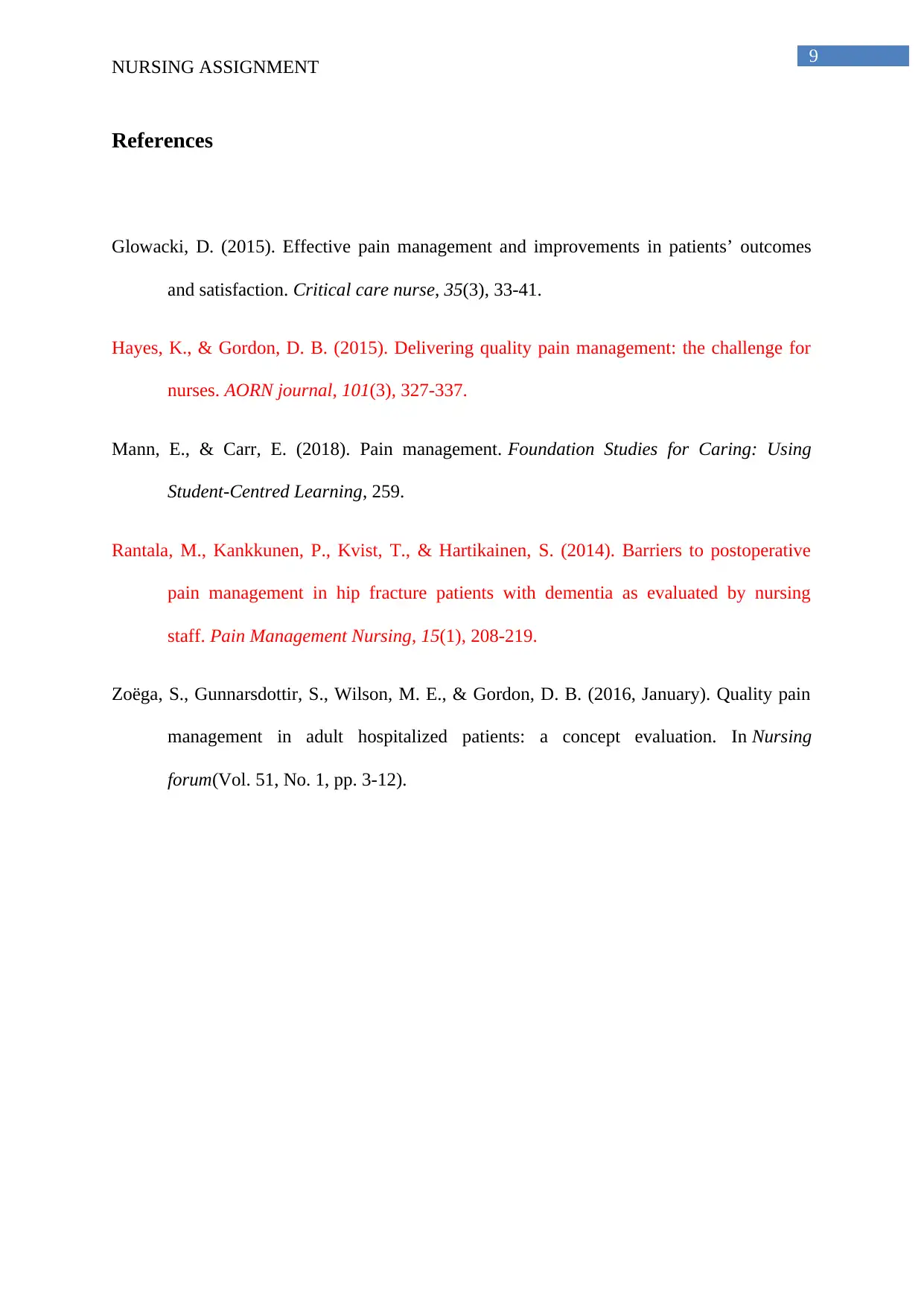
9
NURSING ASSIGNMENT
References
Glowacki, D. (2015). Effective pain management and improvements in patients’ outcomes
and satisfaction. Critical care nurse, 35(3), 33-41.
Hayes, K., & Gordon, D. B. (2015). Delivering quality pain management: the challenge for
nurses. AORN journal, 101(3), 327-337.
Mann, E., & Carr, E. (2018). Pain management. Foundation Studies for Caring: Using
Student-Centred Learning, 259.
Rantala, M., Kankkunen, P., Kvist, T., & Hartikainen, S. (2014). Barriers to postoperative
pain management in hip fracture patients with dementia as evaluated by nursing
staff. Pain Management Nursing, 15(1), 208-219.
Zoëga, S., Gunnarsdottir, S., Wilson, M. E., & Gordon, D. B. (2016, January). Quality pain
management in adult hospitalized patients: a concept evaluation. In Nursing
forum(Vol. 51, No. 1, pp. 3-12).
NURSING ASSIGNMENT
References
Glowacki, D. (2015). Effective pain management and improvements in patients’ outcomes
and satisfaction. Critical care nurse, 35(3), 33-41.
Hayes, K., & Gordon, D. B. (2015). Delivering quality pain management: the challenge for
nurses. AORN journal, 101(3), 327-337.
Mann, E., & Carr, E. (2018). Pain management. Foundation Studies for Caring: Using
Student-Centred Learning, 259.
Rantala, M., Kankkunen, P., Kvist, T., & Hartikainen, S. (2014). Barriers to postoperative
pain management in hip fracture patients with dementia as evaluated by nursing
staff. Pain Management Nursing, 15(1), 208-219.
Zoëga, S., Gunnarsdottir, S., Wilson, M. E., & Gordon, D. B. (2016, January). Quality pain
management in adult hospitalized patients: a concept evaluation. In Nursing
forum(Vol. 51, No. 1, pp. 3-12).
Paraphrase This Document
Need a fresh take? Get an instant paraphrase of this document with our AI Paraphraser

10
NURSING ASSIGNMENT
NURSING ASSIGNMENT
1 out of 11
Related Documents
Your All-in-One AI-Powered Toolkit for Academic Success.
+13062052269
info@desklib.com
Available 24*7 on WhatsApp / Email
![[object Object]](/_next/static/media/star-bottom.7253800d.svg)
Unlock your academic potential
Copyright © 2020–2025 A2Z Services. All Rights Reserved. Developed and managed by ZUCOL.





